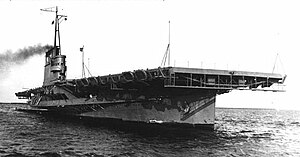 USS Wolverine in Chicago harbor on 22 August 1942.
| |
| History | |
|---|---|
| Name | Seeandbee |
| Owner | Cleveland and Buffalo Transit Company |
| Builder | Detroit Shipbuilding Company,[4] Wyandotte, Michigan |
| Yard number | 190[3] |
| Launched | 9 November 1912[2] |
| Maiden voyage | 19 June 1913 |
| Identification | United States Official Number 211085[1] |
| Fate | Sold to the C & B Transit Company of Chicago for $135,000 |
| Name | Seeandbee |
| Owner | C & B Transit Company of Chicago |
| Fate | Sold to the United States Navy 12 March 1942 for $756,500[note 1] |
| Name | USS Wolverine |
| Namesake | Wolverine |
| Acquired | 2 March 1942 |
| Commissioned | 12 August 1942[7] |
| Decommissioned | 7 November 1945[7] |
| Renamed | Wolverine on 2 August 1942[7] |
| Refit | 6 May 1942 |
| Stricken | 28 November 1945[7] |
| Homeport | Chicago, Illinois (9th Naval District Carrier Qualification Training Unit) |
| Identification |
|
| Honors and awards | |
| Fate | Transferred to the Maritime Commission for disposal 26 November 1947 and sold for scrap December 1947[7][8] |
| General characteristics | |
| Type | Side wheel paddle steamer |
| Tonnage | |
| Displacement | 7,200 long tons (7,300 t)[7] (Wolverine) |
| Length | 500 ft (150 m)[2] |
| Beam |
|
| Draft | 15.5 ft (4.7 m)[7] |
| Decks | 5 |
| Installed power |
|
| Speed | 22 miles per hour (35.4 km/h; 19.1 kn)[2] |
| Complement | 270[7] (Wolverine) |
USS Wolverine (IX-64) was a training ship used by the United States Navy during World War II. She was originally named Seeandbee and was built as a Great Lakes luxury side-wheel steamer cruise ship for the Cleveland and Buffalo Transit Company. Seeandbee was launched on 9 November 1912 and was normally used on the Cleveland, Ohio, to Buffalo, New York, route with special cruises to other ports.[10] After the original owners went bankrupt in 1939 Seeandbee was purchased by Chicago-based C & B Transit Company and continued operating until 1941.[11]
Seeandbee was acquired by the United States Navy in 1942 and was quickly converted into a freshwater aircraft carrier for the advanced training of naval aviators in carrier take-offs and landings.[12] Renamed USS Wolverine, she was not equipped with armor, hangar deck, elevators or armaments.[13][14] As a genuine flattop, Wolverine was shorter, and her flight deck closer to the water, than many of the fighting aircraft carriers of the day. Though unsuited for combat, she was highly functional in her pilot training mission.
The first aircraft landing on USS Wolverine occurred during September 1942.[15] From 1943 until the end of the war in 1945 USS Wolverine along with her sister ship USS Sable was used for the training of 17,000 pilots, landing signal officers and other navy personnel with minimal losses.[16][17] Following the end of World War II the Navy decommissioned Wolverine on 7 November 1945 and she was sold for scrap in December 1947.
- ^ Maritime Administration Vessel Status Card.
- ^ a b c d e f Marine Engineering: June 1913.
- ^ "SEEANDBEE; WOLVERINE, USS, 1942; 127484.127521". Great Lakes Maritime Database. Retrieved 26 November 2017.
- ^ Silverstone, Paul H (1965). US Warships of World War II. Annapolis, Maryland: Naval Institute Press. ISBN 0-87021-773-9.
- ^ 1634–1699: McCusker, J. J. (1997). How Much Is That in Real Money? A Historical Price Index for Use as a Deflator of Money Values in the Economy of the United States: Addenda et Corrigenda (PDF). American Antiquarian Society. 1700–1799: McCusker, J. J. (1992). How Much Is That in Real Money? A Historical Price Index for Use as a Deflator of Money Values in the Economy of the United States (PDF). American Antiquarian Society. 1800–present: Federal Reserve Bank of Minneapolis. "Consumer Price Index (estimate) 1800–". Retrieved 29 February 2024.
- ^ "HyperWar: U.S. Navy Radio Call Sign Book (WWII) [Section 18]". www.ibiblio.org. Retrieved 25 November 2017.
- ^ Interstate Commerce Commission 1916, p. 319.
- ^ "Seeandbee". case.edu. Retrieved 25 November 2017.
- ^ "CRUISING THE GREAT LAKES IN THE 1930s ABOARD THE STEAMER SEEANDBEE". Cruising The Past. Retrieved 25 November 2017.
- ^ Wallace, Irving; David Wallechinsky; Amy Wallace (6 May 1984). "Paddle-Wheel Aircraft Carriers". The Modesto Bee. Modesto, California. p. 48. Retrieved 4 January 2011.
- ^ "Fresh-Water Flattops – The U.S. Navy's Forgotten Great Lakes Aircraft Carriers". MilitaryHistoryNow.com. 29 August 2016. Retrieved 26 November 2017.
- ^ Lee, Bill. "PADDLEWHEEL AIRCRAFT CARRIERS" (PDF). Newport News Shipbuilding Apprentice School Organizations. Retrieved 26 November 2017.
- ^ Ellison, Garret (20 February 2015). "Secret WW2 aircraft carriers on Lake Michigan focus of history project". MLive.com. Retrieved 25 November 2017.
- ^ "Carrier Qualification Training Great Lakes 1942–1945" (PDF). United States Navy.
- ^ "Heroes On Deck – Documentary on USS Sable & Wolverine". Warbirds News. 2 July 2016. Retrieved 25 November 2017.
Cite error: There are <ref group=note> tags on this page, but the references will not show without a {{reflist|group=note}} template (see the help page).